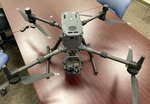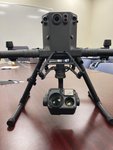By EMMA BARTLETT There are two relatively new technological assets that the Cranston Police Department implemented this past year: Flock safety cameras and the department's three foot by three foot drone. Both are assisting in police investigations and
This item is available in full to subscribers.
We have recently launched a new and improved website. To continue reading, you will need to either log into your subscriber account, or purchase a new subscription.
If you are a current print subscriber, you can set up a free website account by clicking here.
Otherwise, click here to view your options for subscribing.
Please log in to continue |
|


There are two relatively new technological assets that the Cranston Police Department implemented this past year: Flock safety cameras and the department’s three foot by three foot drone. Both are assisting in police investigations and reduce time needed to solve cases.
According to Major Todd Patalano, the 29 Flock safety cameras spread along the city’s public roads have cut investigation time by 50 percent to 80 percent. The cameras take snapshots of vehicles’ and license plate, which goes directly to dispatch. The system works in real time with a three second delay between when the picture is taken and received by the police.
“It’s a great tool to keep the people and citizens and businesses in this city protected. And if something does occur, we have a database we can go to that can lead us in the right direction,” said Patalano.
Before the Flock system, police would speak to witnesses of an incident and track down surveillance cameras in the area where the incident occurred. While officers still take these measures in investigative cases, they can go right to the Flock plate readers and recover an exact picture of a suspect vehicle, which can be immediately broadcast to Cranston’s units to be on the lookout.
Patalano said the department is constantly met with requests from outside departments asking for help in solving crimes. Most recently, Flock assisted Pawtucket PD in the arrest of Michael Alvarado – who was charged in the stabbing and death of Ferdinand Reyes – after a shooting outside of a Pawtucket cigar lounge on Jan. 24; the photo of the vehicle of interest was picked up around Calego Court.
The department’s Flock trial period ended in December and (feeling that it was a necessary tool) Cranston PD has continued the system. Flock requires a yearly fee of $70,000 which the department pays for through grants and other funds.
As for what the department sees on Flock, it’s a combination of stolen vehicles and wanted people. In the last 30 days, the department has seen 463 hot list hits – the number of vehicles that have been flagged whether it be for a wanted person, stolen plates, sex offender entering the city or anything else.
“These people aren’t coming into the city with stolen cars or stolen plates to take a cruise and drive around and visit. They probably have some ulterior motive,” Patalano said.
Flock has also been used several times for missing person cases – enabling police to quickly find people, which would have originally been achieved as fast by searching areas on foot.
Lastly, Flock’s data is extracted after 30 days. There is also a strict policy governing the use of Flock; policemen can only use it for criminal offenses, crimes, and search of missing persons and vehicles.
The department also implemented a drone program last October with the purchase of a $35,000 drone that is three feet by three feet. The associated cost is not for the drone itself, but rather the camera affixed to it. The camera is capable of zooming in on license plates and can be used for surveying crime scenes, search and rescue situations, natural disasters, hostage situations, a barricaded subject and active shooter.
“I think it’s most effective in search and rescue,” Patalano said.
He said that out of the 90,000 calls the department receives each year, many are from concerned family members who have a loved one with Alzheimer’s disease wander off. The drone allows police to cover a vast area in a short amount of time. The camera also has infrared capabilities and can detect body heat in cases where someone may be lost in the dark.
“Time is of the essence,” Patalano said.
In the case of fatal accidents, there can be a tedious litigation process that follows, so achieving an exact snapshot of what an accident looked like from an aerial view can be very valuable evidence down the road.
Patalano said several individuals within the department have been certified with more to soon take training. The goal is to have individuals in each unit trained in using the drone. Captain Vincent McAteer III who has been trained in using the drone said there was a month long certification process that included an exam at the end – the training was similar to what commercial pilots take.
The drone has an obstacle avoidance feature that prevents it from crashing into objects. Additionally, when there is 20 percent battery power left, the drone alerts the user and at 10 percent returns to the location it took off from. Two people needed to use the drone: a pilot and observer and they must always have sight on the drone.
Patalno said the department is constantly looking for ways to do better policing and that many departments throughout the country communicate about tools that are assisting them. Given the size of Cranston’s police department and the amount of calls they handle per year, investing in the drone program was worth pursuing.
Overall, both Flock and the drone program have assisted in improving the efficiency and effectiveness of policing.
Comments
No comments on this item Please log in to comment by clicking here